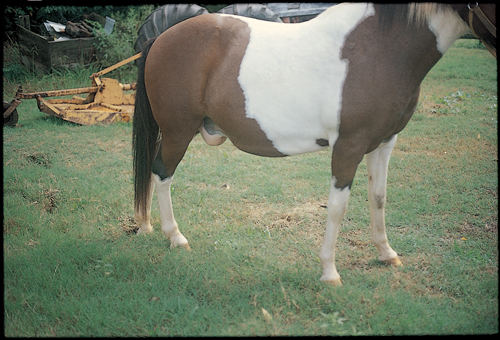Difference between revisions of "Equine Internal Medicine Q&A 05"
Ggaitskell (talk | contribs) (Created page with "{{Template:Manson Mair}} centre|500px<br> <br /> '''Shown is an eight-year-old pony gelding with weight loss (approximately 45kg)...") |
Ggaitskell (talk | contribs) |
||
| Line 13: | Line 13: | ||
|a1= | |a1= | ||
The most likely diagnosis is glomerulonephritis with renal failure. | The most likely diagnosis is glomerulonephritis with renal failure. | ||
| − | |l1= | + | |l1=Glomerulonephritis |
|q2=What is the presumed pathological mechanism of the disease? | |q2=What is the presumed pathological mechanism of the disease? | ||
|a2=The presumed pathological mechanism of glomerulonephritis is persistent immune complex deposition or in situ formation in the glomerulus.<br><br> | |a2=The presumed pathological mechanism of glomerulonephritis is persistent immune complex deposition or in situ formation in the glomerulus.<br><br> | ||
Revision as of 17:42, 5 June 2011
| This question was provided by Manson Publishing as part of the OVAL Project. See more Equine Internal Medicine questions |
Shown is an eight-year-old pony gelding with weight loss (approximately 45kg), inappetence and non-painful pitting oedema of the ventral abdomen. The heart sounds normal, the heart rate is 40bpm and the jugular veins are not distended. The pony is azotaemic (creatinine 194.5␣mol/l; 2.2mg/dl) and the urinalysis reveals specific gravity of 1.014 and proteinuria (urine protein:creatinine ratio 3:1). The PCV of the pony is 35% and the plasma protein is 45g/l.
| Question | Answer | Article | |
| What is the most likely diagnosis in this pony? | The most likely diagnosis is glomerulonephritis with renal failure. |
Link to Article | |
| What is the presumed pathological mechanism of the disease? | The presumed pathological mechanism of glomerulonephritis is persistent immune complex deposition or in situ formation in the glomerulus. In the horse the deposits are most severe within the glomerular capillary walls. |
[[ |Link to Article]] | |
